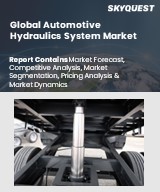
Report ID: SQMIG25A2318

Report ID:
SQMIG25A2318 |
Region:
Global |
Published Date: November, 2024
Pages:
224
|
Tables:
143 |
Figures:
75
Drivers
Increased Focus on Smart Water Treatment
Emphasizing the Vehicle Safety
Restraints
High construction and maintenance costs
Environmental Concerns and the Shift to Electric Vehicles
Our industry expert will work with you to provide you with customized data in a short amount of time.
REQUEST FREE CUSTOMIZATIONWant to customize this report? This report can be personalized according to your needs. Our analysts and industry experts will work directly with you to understand your requirements and provide you with customized data in a short amount of time. We offer $1000 worth of FREE customization at the time of purchase.

Report ID: SQMIG25A2318